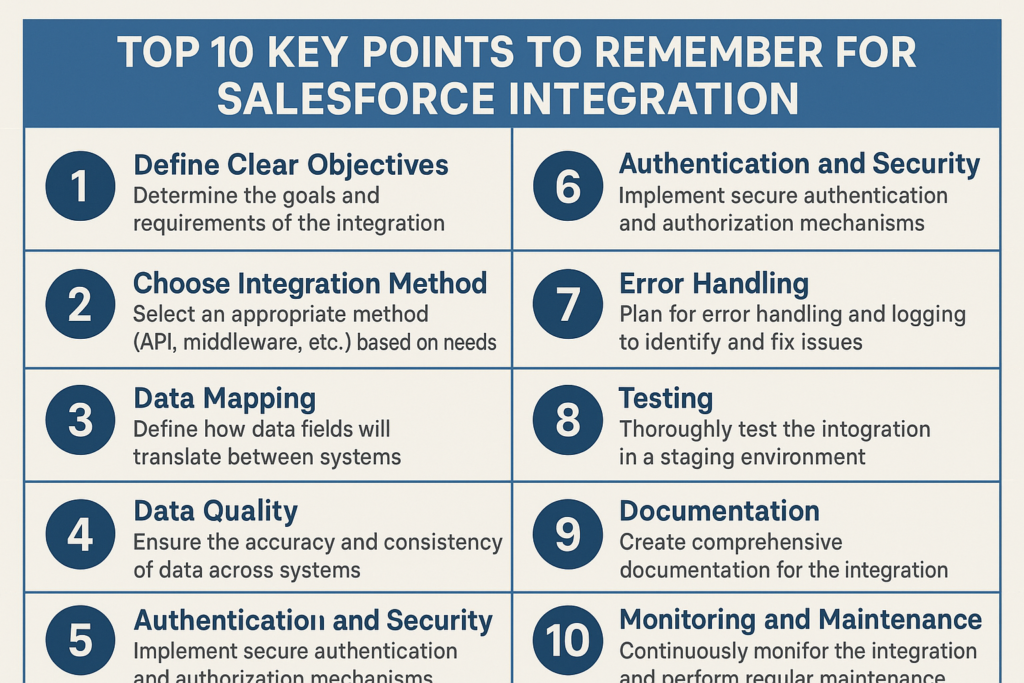Top 10 Key Points to Remember for Salesforce Integration
Salesforce has become the backbone of customer relationship management (CRM) for many organizations. To maximize its potential, it’s often necessary to integrate Salesforce with other systems, such as ERP, marketing automation platforms, or custom applications. However, integration can be complex, and mistakes can lead to data inconsistencies, security risks, or performance issues. Here are the top 10 key points to remember when planning and executing Salesforce integrations.
1. Understand the Integration Type
Before starting any integration, it’s critical to understand the type of integration you need. Salesforce supports:
- Real-time integration – for immediate data updates across systems.
- Batch integration – for processing large volumes of data at scheduled intervals.
- Event-driven integration – using platform events or triggers to respond to changes.
- Near real-time integration – balancing performance and immediacy.
Choosing the right integration type ensures efficiency, accuracy, and minimal system strain.
2. Know Your APIs
Salesforce provides multiple APIs to connect external systems:
- REST API – lightweight, flexible, and ideal for web and mobile apps.
- SOAP API – better suited for enterprise-level, structured integration.
- Bulk API – designed for processing large datasets efficiently.
- Streaming API – for event-driven updates.
- Metadata API – to deploy or retrieve Salesforce configuration and metadata.
Understanding the strengths and limitations of each API ensures you choose the best one for your use case.
3. Consider Security
Security is paramount in Salesforce integrations. Best practices include:
- OAuth 2.0 authentication – secure token-based access.
- Named credentials – simplify connection management.
- IP restrictions – restrict access to trusted networks.
- Encryption and data masking – protect sensitive customer information.
Ensuring secure connections protects both your business and customer data from unauthorized access.
4. Be Mindful of API Limits
Salesforce enforces API limits to maintain platform performance. These include:
- Daily API call limits – vary by edition and license type.
- Concurrent request limits – prevent system overload.
Always plan integration calls efficiently, batch requests where possible, and monitor usage to avoid hitting limits that could interrupt business processes.
5. Use Middleware When Needed
For complex integrations, middleware tools like MuleSoft, Informatica, or Dell Boomi can help by:
- Acting as a bridge between Salesforce and external systems.
- Handling data transformation and orchestration.
- Reducing direct system-to-system dependencies.
Middleware simplifies maintenance, monitoring, and scalability for large organizations.
6. Leverage Platform Events
Salesforce offers Platform Events and Change Data Capture for event-driven integration. Benefits include:
- Immediate synchronization of data across systems.
- Reduced need for constant polling or scheduled jobs.
- Greater flexibility for integrating with microservices or real-time applications.
Event-driven architecture helps keep your systems up-to-date without unnecessary delays.
7. Data Mapping and Transformation
Data in Salesforce may not align perfectly with external systems. Key considerations:
- Field mapping – ensure each Salesforce field maps correctly to the external system.
- Data type conversion – convert data formats like dates, numbers, or picklists as needed.
- Validation rules – enforce consistency and prevent errors during transfer.
Proper data mapping and transformation avoids inconsistencies and ensures data integrity.
8. Error Handling and Logging
Integration failures are inevitable. Mitigation strategies include:
- Robust error handling – catch and respond to errors gracefully.
- Logging mechanisms – record errors, failed records, and transaction histories.
- Alerting and monitoring – notify admins or developers immediately for critical failures.
Having a clear error management strategy ensures faster troubleshooting and minimizes business impact.
9. Test in Sandbox First
Never deploy integrations directly into production. Use a sandbox environment to:
- Validate integration workflows.
- Test with realistic data volumes.
- Catch potential errors before impacting real customers.
Sandbox testing reduces risk and ensures smoother production deployment.
10. Plan for Scalability and Maintenance
Integrations should be designed to grow with your business. Consider:
- Future expansion of data volume or additional systems.
- Maintenance ease for updates, API changes, or system upgrades.
- Documentation for developers and admins for continuity.
A scalable, maintainable integration ensures long-term ROI and reduces operational headaches.
Conclusion
Salesforce integration is a powerful way to connect your CRM with other systems, providing a unified view of customers and enabling smarter business decisions. By remembering these 10 key points, you can design integrations that are secure, efficient, scalable, and reliable.
Successful integration requires planning, the right tools, testing, and ongoing monitoring, but the payoff is a seamless, data-driven customer experience that supports business growth.

